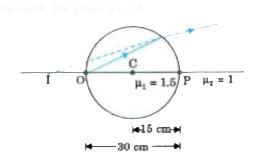A hemisphere of radius 4 cm is placed centrally on cross mark. When it is viewed directly from above what will be the position of the image for the two following cases: (i) when the plane surface of the hemisphere is in contact with the cross mark, (ii) when the curved surface is in contact with the cross mark?
The correct Answer is:(i)4 cm; (ii) 2.5 cm
Topper's Solved these Questions
- REFRACTION OF LIGHTBOOK - CHHAYA PUBLICATIONCHAPTER - REFRACTION OF LIGHTEXERCISE - Hots Numerical Problems
20 Videos
- REFRACTION OF LIGHTBOOK - CHHAYA PUBLICATIONCHAPTER - REFRACTION OF LIGHTEXERCISE - ENTRANCE CORNER
8 Videos
- REFRACTION OF LIGHTBOOK - CHHAYA PUBLICATIONCHAPTER - REFRACTION OF LIGHTEXERCISE - Problem set - I
25 Videos
- REFLECTION OF LIGHTBOOK - CHHAYA PUBLICATIONCHAPTER - REFLECTION OF LIGHTEXERCISE - INTEGER ANSWER TYPE
3 Videos
- SEMICONDUCTORS AND ELECTRONICS BOOK - CHHAYA PUBLICATIONCHAPTER - SEMICONDUCTORS AND ELECTRONICS EXERCISE - CBSE SCANNER
31 Videos
Similar Questions
A glass hemisphere of radius 0.04 m and refractive index of the material 1.6 is placed centrally over cross mark on a paper (i) with the flat face, (ii) with the curved face in contact with the paper. In each case, the cross mark is viewed directly from above. The position of the images will be
View SolutionA mark placed on the surface of glass sphere is viewed through glass from an oppositely directed position. If the diameter of the sphere is 30 cm, locate the image of the mark. For glass, μ=1.5

View Solution
Knowledge Check
A glass hemisphere of radius 0.04 m and refractive index of the material 1.6 is placed centrally over cross mark on a paper (i) with the flat face, (ii) with the curved face in contact with the paper. In each case, the cross mark is viewed directly from above. The position of the images will be
A(i) 0.04 m from the flat face, (ii) 0.025 m from the flat faceB(i) at the same position of the cross mark, (ii) 0.025 m below the flat faceC(i) 0.025 m from the flat face, (ii) 0.04 m from the flat faceDfor both (i) and (ii) 0.025 m from the highest point of the hemisphere
Calculate equivalent focal length of plano convex lens for following case:-
(i) When curved surface is silvered.
(ii) When plane surface is silvered.
View SolutionCalculate equivalent focal length of plano convex lens for following case:-
(i) When curved surface is silvered.
(ii) When plane surface is silvered.
View SolutionCalculate equalant focal length of plano convex lens for following case :–
(i) When curved surface is silvered.
(ii) When plane surface is silvered.
View SolutionA glass hemisphere of radius 10cm and μ=1.5 is silvered over its curved surface. There is an air bubble in the glass 5cms from the plane surface along the axis. Find the position of the images of this bubble seen by observer looking along the axis into the flat surface of the atmosphere.
View SolutionA glass hemisphere of radius 10cm and μ=1.5 is silvered over its curved surface. There is an air bubble in the glass 5cms from the plane surface along the axis. Find the position of the images of this bubble seen by observer looking along the axis into the flat surface of the atmosphere.
View SolutionA mark on the surface of a glass spehre (μ=1.5) is viewed from a diametrically opposite position. It appears to be at a distance 10 cm from its actual position. The radius of the sphere is
View SolutionA plano-convex lens has a maximum thickness of 6 cm. When placed on a horizontal table with the curved surface in contact with the table surface, then the apparent depth of the bottom most point of the lens is found to be 4 cm. If the lens is inverted such that the plane face of the lens is in contact with the surface of the table, then the apparent depth of the centre of the plane face is found to be 174 cm. The radius of curvature of the lens is
View Solution
